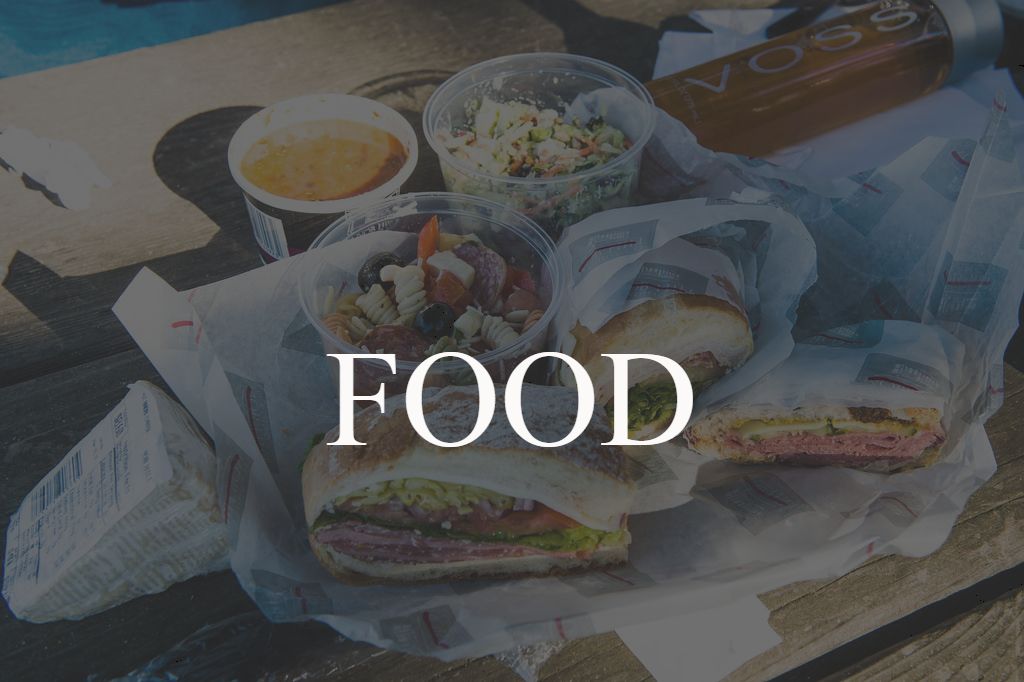5 Wine Terms You Should Know To Sound Like A Pro!
With every serving shift I have ever worked, there is a minimum of two times in the night where someone will ask for a wine recommendation by the glass. I will then ask them “What kind of wine do you like to drink?”
Inevitably someone will answer “I like dry reds”.
This brings me to the point of the MOST misused wine term I have ever heard spoken: dry. WHY are people so confused with this wine term and it’s meaning? What does dry in terms of describing wine actually mean?? Public Service Announcement: Saying you like your red wine dry, is akin to saying you like your water wet. It’s implied!
Here are the five wine terms you really need to know to sound like you know more than perhaps you do. I am of the school of thought: fake it 'til you make it.
1. Dry.
It’s as simple as this: absence of sweetness! Please, please, please stop saying you like dry wines when you mean you like wines with tannins. How the wine feels in your mouth is not to say the wine is dry! (dry-ING = tannins!) To get a little more technical and fully understand this, you need to know a little bit about how wine is made - that is, how the grapes go from fruit to the alcoholic beverage we drink.
After grapes are crushed, they go through a process called fermentation. This occurs when yeast is added to the must, (juice of wine grapes through pressing and crushing), the yeast eat the sugar and the bi product left is ethanol. If the yeast eats all the sugar, a dry wine is produced. If the winemaker stops the fermentation process early, not all the sugar is converted to alcohol, and a sweeter wine is made. This is why any wine grape can be made into sweet, off-dry, or dry styles, but one very commonly known grape that is made into both sweet and dry styles is Riesling. One way to tell if the wine will be sweet or dry, is to look at the alcohol content - if the alcohol content is around 9-10%, then that wine will be sweet. If the wine is 11-13% alcohol, then that wine is generally dry. One thing to note is that almost every wine on a wine-by-the-glass list is dry, because people tend to drink dry wines with food. The exception is a dessert menu; this is where you will find sweet wines: Port, Sauterne, Late Harvest Riesling, are all examples of dessert wine.
Tip: Red wines that you drink with dinner are all dry, so no need to say that you like a dry red! You can however say that you like a dry white wine, as there are off-dry styles available by the glass on a typical menu. What about buying wine in a store, not a wine list? How do you know which reds are dry? Again, all dry means is the absence of residual sugar, most people want a tiny bit of residual sugar to make the wine balanced and not too bitter, however, if you want bone dry: stay away from cheap, new-world wines (sub $10). These wines tend to have 12-15g of residual sugar: Menage Trois, Yellow Tail Shiraz, Apothic Red.
2. Body.
The body of the wine refers to how thick or thin the wine feels in your mouth. Cabernet Sauvignon is a full bodied wine, where Pinot Noir is a light-medium bodied wine. On the white side, Sauvignon Blanc is a light-bodied wine, and Chardonnay is medium to full-bodied. It can be helpful if you think of wine in terms of milk. You have your low-fat, reduced-fat, and whole milk. The lower the fat percentage in milk, the lighter the body, or less thick it feels in your mouth. With wine, body can be in proportion to alcohol content. The higher the alcohol, the fuller-bodied the wine can be. You can tell how full bodied a wine will be in most cases by simply looking at it through the glass. If you tilt the glass 45 degrees and then pull the glass back upright, is there staining left on the glass that appears viscous or syrupy? This is indicative of a full-bodied wine.
Tip: If you are at a restaurant and you know you like Pinot Noir, but it is too expensive for your budget, or they simply do not have it available, you may like Beaujolais - a lighter bodied more budget-conscious wine. It is helpful to know where you like your Pinot Noir from too, because a Pinot Noir from Willamette Valley is going to taste more earthy and less fruity than one from Sonoma, as the soil types, climate, and wine making practices of these regions can differ greatly.
3. Tannins.
Tannins are found in many foods and beverages, not just wine. Tannins are incorporated into the wine to create that drying mouthfeel - NOT to be confused with what dry means in reference to wine. A wine can be dry, but not “drying” in your mouth - Sauvignon Blanc, and Pinot Noir are examples of this. Tannins come from wine grapes’ seeds and skins, and are prevalent in deep colored, full-bodied wines by majority. Tannins create a bitter taste that can balance out a wine’s sweetness and add complexity and structure to the overall tasting experience. If you have ever let a tea bag steep too long in your cup, and subsequently winced because it was too bitter to drink, you have experienced tannin-overload. Tannins are in coffee, bark, nuts, cranberries, legumes, chocolate, and most non-citrus fruit juices. In my experience, most wine drinkers confuse the word tannin for dry, and vice-versa when they are ordering wine in a restaurant. It sort of drives me crazy - if you couldn’t already tell!
Tip: Tannins are one of the greatest wine-pairing tools because wines that are high in tannins, tend to cut through fattier meat dishes - hence the classic pairing of steak with Cabernet Sauvignon. Other high tannin wines: Nebbiolo, Sangiovese, Syrah, Montepulciano, Petit Verdot, and Malbec.
4. Earthy.
You might be asked if you like your wine earthy or fruity, but what does earthy mean? Wine’s flavor is so much predicated on where the grapes were grown, and the easiest way to explain this is cooler climate versus warmer climate. When grapes are grown in a cool climate region like Willamette Valley, Chablis, and Trentino-Alto Adige, Italy they produce wines that are less fruity smelling, and instead have aromas of forest floor, wild mushrooms, wet concrete, fall leaves, and minerals (also referred to as minerality). This is because the grapes are less sweet, have higher acid levels, and do not get to the ripeness levels as do grapes from hotter climates. If you like French Cabernet Franc, Burgundian Pinots or Malbec from Cahors, you tend to like earthier red wines. The opposite of earthy is jammy, which is a wine term that most wine snobs will scoff at because to them it implies wines that are less sophisticated. The fabulous thing about wine that I wish more people would accept is that wine is a personal preference drink. I think jammy wines are absolutely delicious - especially high tannin, fruit-forward wines.
Tip: If you think you might like jammy wines, some great wines to try are Zinfandels from Oregon's Applegate Valley or Columbia River Gorge. Windhorse Vineyard in The Dalles, Stave & Stone in Hood River and Almaterra in The Dalles make some of my favorite jammy Zins!
5. Opulent.
If you get comfortable using this wine term, you are guaranteed to impress your wine-drinking friends. Instead of using words like bold, smooth, and rich, get in the habit of saying “I like wines that are opulent”. An example of an opulent red wine would be a Syrah, because it is rich and deep in color, and can pack a punch with a full body and integrated tannins. Syrah, can be one of the best-in-balance wines, meaning no one thing stands out - the alcohol isn’t super pungent on the nose, there’s equal parts fruitiness to acidity, and the tannins are smooth, yet still bold, not overly intense. I have had some Syrahs which I would describe as flabby, meaning the wine coats my mouth, but doesn’t have a tannic structure or acidity to play off the full mouthfeel. Many red blends I would describe as opulent, because when all things are in balance, I find them to be rich, bold, and highly satisfying palate pleasers. I would also describe any red wine that is jammy (meaning smells like cooked fruit on the nose), full-bodied, with tannins that do not overpower as opulent.
Tip: Next time you have your favorite wine, think of which terms you could use to describe the wine. When you are out, you are sure to find something you like based on your newly discovered wine vocabulary. Keep in mind that service professionals like helping you discover new wines, so it’s great to know these terms fluently, so you can help the pros help you!
With every serving shift I have ever worked, there is a minimum of two times in the night where someone will ask for a wine recommendation by the glass. I will then ask them “What kind of wine do you like to drink?”
Inevitably someone will answer “I like dry reds”.
This brings me to the point of the MOST misused wine term I have ever heard spoken: dry. WHY are people so confused with this wine term and it’s meaning? What does dry in terms of describing wine actually mean?? Public Service Announcement: Saying you like your red wine dry, is akin to saying you like your water wet. It’s implied!
Here are the five wine terms you really need to know to sound like you know more than perhaps you do. I am of the school of thought: fake it 'til you make it.
1. Dry.
It’s as simple as this: absence of sweetness! Please, please, please stop saying you like dry wines when you mean you like wines with tannins. How the wine feels in your mouth is not to say the wine is dry! (dry-ING = tannins!) To get a little more technical and fully understand this, you need to know a little bit about how wine is made - that is, how the grapes go from fruit to the alcoholic beverage we drink.
After grapes are crushed, they go through a process called fermentation. This occurs when yeast is added to the must, (juice of wine grapes through pressing and crushing), the yeast eat the sugar and the bi product left is ethanol. If the yeast eats all the sugar, a dry wine is produced. If the winemaker stops the fermentation process early, not all the sugar is converted to alcohol, and a sweeter wine is made. This is why any wine grape can be made into sweet, off-dry, or dry styles, but one very commonly known grape that is made into both sweet and dry styles is Riesling. One way to tell if the wine will be sweet or dry, is to look at the alcohol content - if the alcohol content is around 9-10%, then that wine will be sweet. If the wine is 11-13% alcohol, then that wine is generally dry. One thing to note is that almost every wine on a wine-by-the-glass list is dry, because people tend to drink dry wines with food. The exception is a dessert menu; this is where you will find sweet wines: Port, Sauterne, Late Harvest Riesling, are all examples of dessert wine.
Tip: Red wines that you drink with dinner are all dry, so no need to say that you like a dry red! You can however say that you like a dry white wine, as there are off-dry styles available by the glass on a typical menu. What about buying wine in a store, not a wine list? How do you know which reds are dry? Again, all dry means is the absence of residual sugar, most people want a tiny bit of residual sugar to make the wine balanced and not too bitter, however, if you want bone dry: stay away from cheap, new-world wines (sub $10). These wines tend to have 12-15g of residual sugar: Menage Trois, Yellow Tail Shiraz, Apothic Red.
2. Body.
The body of the wine refers to how thick or thin the wine feels in your mouth. Cabernet Sauvignon is a full bodied wine, where Pinot Noir is a light-medium bodied wine. On the white side, Sauvignon Blanc is a light-bodied wine, and Chardonnay is medium to full-bodied. It can be helpful if you think of wine in terms of milk. You have your low-fat, reduced-fat, and whole milk. The lower the fat percentage in milk, the lighter the body, or less thick it feels in your mouth. With wine, body can be in proportion to alcohol content. The higher the alcohol, the fuller-bodied the wine can be. You can tell how full bodied a wine will be in most cases by simply looking at it through the glass. If you tilt the glass 45 degrees and then pull the glass back upright, is there staining left on the glass that appears viscous or syrupy? This is indicative of a full-bodied wine.
Tip: If you are at a restaurant and you know you like Pinot Noir, but it is too expensive for your budget, or they simply do not have it available, you may like Beaujolais - a lighter bodied more budget-conscious wine. It is helpful to know where you like your Pinot Noir from too, because a Pinot Noir from Willamette Valley is going to taste more earthy and less fruity than one from Sonoma, as the soil types, climate, and wine making practices of these regions can differ greatly.
3. Tannins.
Tannins are found in many foods and beverages, not just wine. Tannins are incorporated into the wine to create that drying mouthfeel - NOT to be confused with what dry means in reference to wine. A wine can be dry, but not “drying” in your mouth - Sauvignon Blanc, and Pinot Noir are examples of this. Tannins come from wine grapes’ seeds and skins, and are prevalent in deep colored, full-bodied wines by majority. Tannins create a bitter taste that can balance out a wine’s sweetness and add complexity and structure to the overall tasting experience. If you have ever let a tea bag steep too long in your cup, and subsequently winced because it was too bitter to drink, you have experienced tannin-overload. Tannins are in coffee, bark, nuts, cranberries, legumes, chocolate, and most non-citrus fruit juices. In my experience, most wine drinkers confuse the word tannin for dry, and vice-versa when they are ordering wine in a restaurant. It sort of drives me crazy - if you couldn’t already tell!
Tip: Tannins are one of the greatest wine-pairing tools because wines that are high in tannins, tend to cut through fattier meat dishes - hence the classic pairing of steak with Cabernet Sauvignon. Other high tannin wines: Nebbiolo, Sangiovese, Syrah, Montepulciano, Petit Verdot, and Malbec.
4. Earthy.
You might be asked if you like your wine earthy or fruity, but what does earthy mean? Wine’s flavor is so much predicated on where the grapes were grown, and the easiest way to explain this is cooler climate versus warmer climate. When grapes are grown in a cool climate region like Willamette Valley, Chablis, and Trentino-Alto Adige, Italy they produce wines that are less fruity smelling, and instead have aromas of forest floor, wild mushrooms, wet concrete, fall leaves, and minerals (also referred to as minerality). This is because the grapes are less sweet, have higher acid levels, and do not get to the ripeness levels as do grapes from hotter climates. If you like French Cabernet Franc, Burgundian Pinots or Malbec from Cahors, you tend to like earthier red wines. The opposite of earthy is jammy, which is a wine term that most wine snobs will scoff at because to them it implies wines that are less sophisticated. The fabulous thing about wine that I wish more people would accept is that wine is a personal preference drink. I think jammy wines are absolutely delicious - especially high tannin, fruit-forward wines.
Tip: If you think you might like jammy wines, some great wines to try are Zinfandels from Oregon's Applegate Valley or Columbia River Gorge. Windhorse Vineyard in The Dalles, Stave & Stone in Hood River and Almaterra in The Dalles make some of my favorite jammy Zins!
5. Opulent.
If you get comfortable using this wine term, you are guaranteed to impress your wine-drinking friends. Instead of using words like bold, smooth, and rich, get in the habit of saying “I like wines that are opulent”. An example of an opulent red wine would be a Syrah, because it is rich and deep in color, and can pack a punch with a full body and integrated tannins. Syrah, can be one of the best-in-balance wines, meaning no one thing stands out - the alcohol isn’t super pungent on the nose, there’s equal parts fruitiness to acidity, and the tannins are smooth, yet still bold, not overly intense. I have had some Syrahs which I would describe as flabby, meaning the wine coats my mouth, but doesn’t have a tannic structure or acidity to play off the full mouthfeel. Many red blends I would describe as opulent, because when all things are in balance, I find them to be rich, bold, and highly satisfying palate pleasers. I would also describe any red wine that is jammy (meaning smells like cooked fruit on the nose), full-bodied, with tannins that do not overpower as opulent.
Tip: Next time you have your favorite wine, think of which terms you could use to describe the wine. When you are out, you are sure to find something you like based on your newly discovered wine vocabulary. Keep in mind that service professionals like helping you discover new wines, so it’s great to know these terms fluently, so you can help the pros help you!















